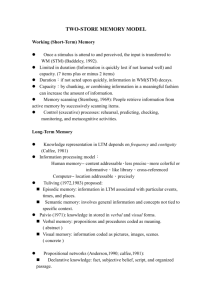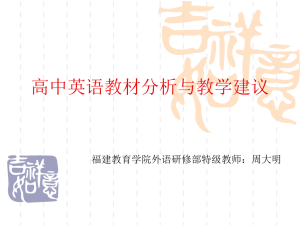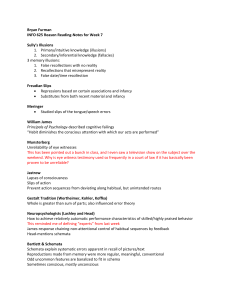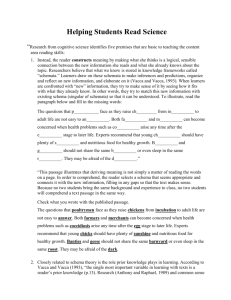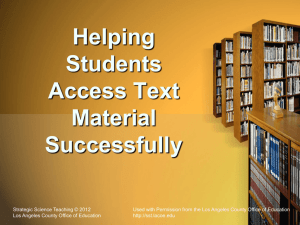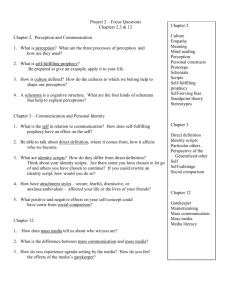02/10/2014
advertisement
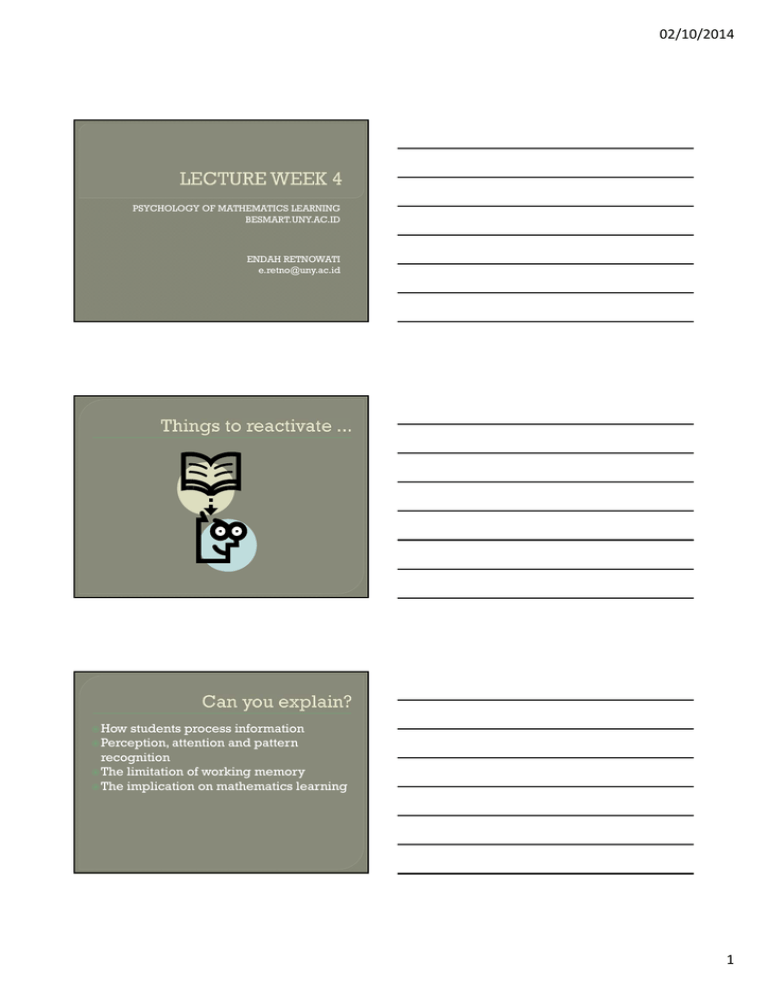
02/10/2014 PSYCHOLOGY OF MATHEMATICS LEARNING BESMART.UNY.AC.ID ENDAH RETNOWATI e.retno@uny.ac.id How students process information and pattern recognition The limitation of working memory The implication on mathematics learning Perception, attention 1 02/10/2014 LEARNING PROCESS: organise information, build connection among information and integration with prior knowledge, and eventually construct knowledge, encode knowledge to LTM SELECTING PATTERN RECOGNITION FORGOTTEN What is in your mind now? Limited in capacity • Miller’s research: the magic number of seven (7±2 chunks of new meaningful information) • Cowan’s research: 4±1 chunks of new information to be processed Limited in duration • Recalls decay over time unless actively rehearsal occurs • Information lost very rapidly when people are distracted from rehearsing • Forgetting occurs due to interference (of new information) rather than time Dual-coding theory – expert attempts to extend student’s ability to process more bits of information by providing both audio and visual information simultaneously 2 02/10/2014 Executive Control System (Control the operations of WM) Phonological loop (Auditory rehearsal) Visual-spatial sketch pad (Visual researsal) Verbal coding system is where linguistically based information is coded (words, sentences, stories, the content of information) Imaginal coding system is where non verbal information is coded (pictures, sounds, sensations) Coding words and pictures are independent Information that can be coded into both systems is more easily recalled Images (concrete information, e.g. birds, graph) are easier to recall than words (abstract information, e.g. Soar, value) Pictures are more memorable than words LEARNING PROCESS: organise information, build connection among information and integration with prior knowledge, and eventually construct knowledge, encode knowledge to LTM SELECTING PATTERN RECOGNITION FORGOTTEN 3 02/10/2014 Processing “unlimited” amount of information that is already familiar. Give example! Implication of limited working memory when dealing with novel information for learning new mathematics problem? LEARNING PROCESS: organise information, build connection among information and integration with prior knowledge, and eventually construct knowledge, encode knowledge to LTM SELECTING PATTERN RECOGNITION FORGOTTEN 4 02/10/2014 Unconcious component of our memory capacity and duration Where cognitive structures are organised Unlimited Explicit memory • Conscious recall, recognition of previous knowledge/information/experience Implicit memory • No record of previously remembering events • Retention without remembering “...and the young men went ashore from his house and made a fire. And he told everybody and said ‘Behold, I accompanied the ghost, and we went to a fight. Many of our fellows were killed. And they said I was hit and I did not feel sick’. He told it all and they became quiet. When the sun rose he fell down. Something black came out of his mouth. His face became contorted. The people jumped up and cdried. He was dead.” (Bartlett, 1932) 1. Declarative knowledge Domain specific Knowing what Knowing how Knowing when and why 2. Procedural knowledge 3. Conditional knowledge Classify the following: Using a computer Writing formula Finding area Solving an algebraic equation 5 02/10/2014 Semantic memory • A mental thesaurus, organised knowledge a person possesses about words and other verbal symbols, their menings and referents, about relations among them, about formulas, and algoriths for the manipilation of these symbols, concepts and relations (Endel Tulving, 1972) Episodic memory Episodic memory • Stores information about ‘episodes’ or ‘events’ in our lives The learning order in the classroom Makes mistakes ... • Unique to student *it is still on debate Brown and Kulik (1977) defined flashbulb memory as a vividly detailed memory of the circumstances under which first learnerd of a surprising, consequential, emotionally involving event Categories: • Informant • Place where the news was heard • Ongoing event • Individual’s own emotional state • Consequences of the ecent for the individual 6 02/10/2014 A lot of everyday thinking involves remembering to carry out intended actions Time based memory involves remembering to perform an action at a particular time Event based memory involves remembering to perform a task in the approriate circumstances What is the implication of having various types of knowledge (memory) stored in LTM on mathematics learning? Recognise that what students already know influences what they will learn Help students activate current knowledge Help students organised knowledge into meaningful ‘chunks’ ‘proceduralise’ declarative knowledge Present information both verbally and non verbally (more detail on next lecture) 7 02/10/2014 How we store and build knowledge can we best conceptualise the information stored in LTM Various theories are proposed Each helps us think about LTM in a different way How Those representing declarative knowledge are: • Concepts • Propositions • Schemata Those representing procedural knowledge are: • Productions • Scripts Concets represent ‘meaningful categories’ • Green, cat, lecture, man, classroom • Area, square, addition, multiplier Features essential to defining a concepdt are definind attributes • Wings are defining attributes of bird • Sides are ddefininf attributes of rectangle 8 02/10/2014 Rectangle • What are the ‘defining attributes” • What are the ‘non-defining attributes” Those representing declarative knowledge are: • Concepts • Propositions • Schemata Those representing procedural knowledge are: • Productions • Scripts A proposition is the smallest unit of meaning able to be judge true or false • ‘Anna held the white cat’ has two propositions: Anna held the cat and the cat is white • ‘The area formula of a rectangle is the leght times the width’ has how many propositions? The number of the propositions shows how much information stored in LTM More complex than the concepts they include 9 02/10/2014 Propositions that share information are linked in propositional networks ‘Anna held the cat’ ‘The cat is white’ ‘The area formula of a rectangle is the leght times the width’ Those representing declarative knowledge are: • Concepts • Propositions • Schemata Those representing procedural knowledge are: • Productions • Scripts 10 02/10/2014 Are networks of generalised information about a topic “organised structures that capture knowledge and expectations of some aspect of the world” (Bartlett, 1932) “abstract knowledge structures that organised a vast amount of information” (Woolfolk & Margetts, 2007) Terminology: • Schema = singular • Schemata = plural • Instantiation = provide a specific instance, representing a concept/event Schemata are instantiated when a particular situation occurs in which enough values are met that the schema is activated • More instances can then be accessed Schema theory is more comprehensive than concept or proposition theory Most commonly used framework for understanding knowledge in LTM Schemata contro encoding, storage and retrieval of LTM 11 02/10/2014 Think of the following story: The student sat looking at his *****. “old friend” he thought, “this hurts me”. A tear rolled down his chhek. He hesitated, then picked up his tap shoe and raised his arm. “Tick tick tick” ... He did what he had to do.... Could you have understood it without activation of your “calculator” schema? Calculator object Physically Purpose Access - Has button -rectangle -has screen -count -work assitance -graph -not always permitted to use -need battery -can be broken HOW HOW SCHEMA IS CONSTRUCTED SCHEMA IS AUTOMATED Metacognition task: Why we need to discuss these? 12 02/10/2014 LTM is actively constructed using schemata Activated schemata determine what incoming information is relevant Schemata are continually reconstructed through learning LTM is actively constructed using schemata Activated schemata determine what incoming information is relevant Schemata are continually reconstructed through learning What do you remember from the story excerpt you saw earlier in the lecture? 13 02/10/2014 Bartlett (1932) aimed to investigate recall stories from different cultures • Schemata include expectations, stereotypes, etc • If schemata are drawn on, participants’ story recall should reflect these • Recall of stories was not entirely accurate Unfamiliar data was omitted (because cannot link with own schemata) Other material was altered (using own schemata) Provides evidence schema theory: that knowledge in LTM is actively constructed using schemata What is the implication on mathematics learning? LTM is actively constructed using schemata Activated schemata determine what incoming information is relevant Schemata are continually reconstructed through learning 14 02/10/2014 The area of a paddy field is 1000 metres square and is divided into three smaller areas. What could it be the area of the smaller areas? Activated schemata? What students will attempt? LTM is actively constructed using schemata Activated schemata determine what incoming information is relevant Schemata are continually reconstructed through learning ASSIMILATION • New information that fits into an existing schema is added ACCOMODATION • Existing schemata are modified in the face of new, confliting information 15 02/10/2014 Use mathematics learning context THIS IS YOUR ASSIGNMENT TODAY 16 02/10/2014 Those representing declarative knowledge are: • Concepts • Propositions • Schemata Those representing procedural knowledge are: • Productions • Scripts Recognise that what students already know influences what they will learn Help students activate current knowledge Help students organised knowledge into meaningful ‘chunks’ ‘proceduralise’ declarative knowledge Present information both verbally and non verbally LEARNING PROCESS: organise information, build connection among information and integration with prior knowledge, and eventually construct knowledge, encode knowledge to LTM SELECTING PATTERN RECOGNITION FORGOTTEN 17
